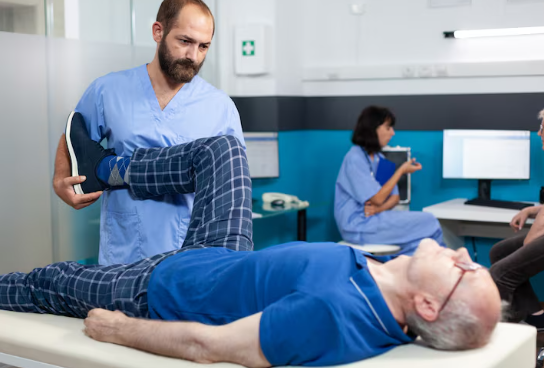Who Can Perform a DOT Physical and Why It Matters?

Understanding The Purpose Of A DOT Physical
So, you’re getting ready to drive a big rig or maybe a bus, and you’ve heard about this thing called a DOT physical. What’s the deal with it, anyway? Basically, it’s a check-up required by the Federal Motor Carrier Safety Administration (FMCSA) to make sure you’re healthy enough to handle the demands of driving a commercial vehicle. It’s not just about having a clean driving record; it’s about your physical and mental well-being, too.
Ensuring Driver Health And Safety
The main goal here is pretty straightforward: keep everyone on the road safe. Driving a commercial vehicle is a serious job. You’re responsible for a lot of metal, and often, a lot of people. The DOT physical looks for any health issues that could suddenly pop up and make driving dangerous. Think about things like vision problems that make it hard to see signs, or a heart condition that could cause a problem while you’re miles from anywhere. This exam helps catch those potential issues before they lead to an accident.
Reducing Road Accidents
When drivers are medically fit, the chances of accidents caused by health-related incidents go way down. It’s a proactive step. Instead of waiting for something to happen, the DOT physical identifies potential risks. This means fewer unexpected medical emergencies behind the wheel, which can be catastrophic when you’re driving something large and heavy.
Protecting Public Welfare
Ultimately, this whole process is about protecting everyone. When you get your DOT physical, you’re not just doing it for yourself or your employer. You’re contributing to the safety of every other car, truck, and person on the road. It’s a way to make sure that only qualified and healthy individuals are operating these large vehicles, which benefits the entire community.
The DOT physical is a key part of the system designed to keep our roads safer for everyone. It’s a requirement that makes sense when you consider the responsibility that comes with driving a commercial vehicle.
Who Is Qualified To Perform A DOT Physical
So, you’re wondering who gets to give the official nod on whether you’re fit to drive that big rig or passenger bus? It’s not just any doctor you can walk into. The Federal Motor Carrier Safety Administration (FMCSA) has specific rules about this, and it all comes down to having a certified medical examiner. These aren’t just regular physicians; they’ve gone through extra training and are registered with the FMCSA to perform these specialized exams.
The Role Of Certified Medical Examiners
A certified medical examiner is the only person authorized to conduct a DOT physical. They’re trained to understand the specific medical demands of commercial driving. This means they know what conditions could potentially affect your ability to operate a vehicle safely, like issues with vision, hearing, or even certain heart conditions. They’re looking out for everyone on the road, not just you.
FMCSA National Registry Requirements
To be a certified medical examiner, professionals must be listed on the FMCSA’s National Registry. This registry is a public database of examiners who have met the FMCSA’s training and certification standards. Think of it as their official stamp of approval. If an examiner isn’t on this list, their physical won’t count, and you’ll have to get it done again.
Here’s a quick rundown of what it takes:
- Complete FMCSA-approved training courses.
- Pass a rigorous certification exam.
- Maintain their certification through ongoing training.
- Be licensed, registered, or certified in their state to perform physical examinations.
Understanding Examiner Qualifications
While the FMCSA sets the national standard, examiners can come from various medical backgrounds. This typically includes:
- Doctors of Medicine (MD)
- Doctors of Osteopathy (DO)
- Physician Assistants (PAs)
- Advanced Practice Registered Nurses (APRNs), including Nurse Practitioners (NPs)
It’s important to remember that not all healthcare providers are qualified. They must be specifically trained and listed on the National Registry. You can even check the registry yourself to find an examiner near you. It’s a good idea to find someone who is familiar with DOT physicals to make the process smoother.
The goal is to have a consistent standard across the board. This way, every commercial driver is evaluated using the same criteria, no matter where they get their physicals done. It keeps things fair and, more importantly, safe.
When you schedule your DOT physical, always confirm that the medical examiner is certified and listed on the FMCSA National Registry. This simple step can save you a lot of hassle down the road.
Key Components Of The DOT Physical Exam
So, what exactly goes down during a DOT physical? It’s not just a quick glance; it’s a thorough check to make sure you’re fit for the road. Think of it like a detailed inspection, but for your body.
Medical History Review
First off, the examiner will want to know about your health background. This means filling out a form about any past illnesses, surgeries, or ongoing conditions like diabetes or heart problems. They’ll also ask about medications you’re currently taking, and if you use tobacco, alcohol, or other substances. Being completely honest here is super important because it helps the medical examiner get a full picture of your health and any potential risks.
Vision And Hearing Assessments
Can you see the road signs clearly? Can you hear important alerts? These are big questions. The exam includes tests to check your vision, making sure you meet the minimum requirements for distance and peripheral vision. They’ll also test your hearing to ensure you can pick up on critical sounds.
Physical Examination And Vital Signs
This is where the examiner does a hands-on check. They’ll measure your blood pressure, check your pulse, and listen to your heart and lungs. They’ll also look for any physical limitations that might affect your ability to drive safely. This part covers a lot of ground, from checking your reflexes to looking for signs of sleep apnea or other conditions that could cause sudden incapacitation.
Urinalysis And Other Tests
Yep, you’ll need to provide a urine sample. This isn’t just for drug testing, though that can be part of it. The urinalysis can also reveal signs of underlying health issues like diabetes or kidney problems. Depending on what the examiner finds or your medical history, they might also order other tests, like an electrocardiogram (ECG) to check your heart’s electrical activity.
The goal of all these checks is pretty straightforward: to confirm you can handle the demands of driving a commercial vehicle without posing a risk to yourself or others on the road. It’s all about safety, plain and simple.
Why The DOT Physical Matters For Drivers
So, you’re a commercial driver, and you’ve got this DOT physical thing hanging over your head. It might seem like just another hoop to jump through, but honestly, it’s pretty important for a few solid reasons. It’s not just about the government checking boxes; it’s about keeping you and everyone else on the road safe.
Maintaining Driving Eligibility
This is the big one, right? Without passing your DOT physical, you can’t legally drive your commercial vehicle. The Federal Motor Carrier Safety Administration (FMCSA) has these rules to make sure folks behind the wheel of big rigs and buses are actually healthy enough to do the job. Think about it: operating a massive vehicle requires good vision, hearing, and the ability to stay alert. If you’ve got a condition that could suddenly impair you – like uncontrolled high blood pressure or a vision problem that’s gotten worse – it’s a risk.
- Vision: You need to see clearly, both near and far. This includes checking for conditions like glaucoma or cataracts.
- Hearing: Being able to hear important sounds, like horns or emergency sirens, is key.
- Physical Fitness: The exam checks your general physical condition, looking for issues that could cause sudden incapacitation.
Passing this physical means you get to keep doing the job you’re trained for. It’s your ticket to staying on the road legally and professionally.
Promoting Personal Health Awareness
Let’s be real, sometimes we put our health on the back burner when we’re busy. The DOT physical is a good kick in the pants to pay attention to your body. It’s a chance to catch potential health problems early, before they become serious issues. Maybe your blood pressure has been creeping up, or you’ve been feeling more tired than usual. The exam can flag these things.
The DOT physical isn’t just a test to see if you can drive; it’s a health check-up that can help you stay healthier longer. Identifying issues early means you can get treatment and manage your health better, which benefits you both on and off the road.
This proactive approach can make a real difference in your long-term well-being. It’s an opportunity to talk with a medical professional about any concerns you might have and get advice on how to stay in top shape.
Career Longevity and Professionalism
Being a commercial driver is a career, and like any career, you want to be able to do it for a long time. Staying on top of your health through regular DOT physicals contributes to that. It shows you’re serious about your profession and committed to meeting industry standards. Employers look for drivers who are reliable and responsible, and that includes taking care of their health.
- Reliability: Drivers who pass their physicals are seen as more dependable.
- Professional Image: It signals that you adhere to the rules and take your job seriously.
- Reduced Downtime: Catching health issues early can prevent unexpected absences from work due to illness.
Ultimately, taking the DOT physical seriously is part of being a professional in the transportation industry. It’s about ensuring you can continue your career safely and effectively for years to come.
Employer Responsibilities For DOT Physicals
Look, running a trucking company or any business that involves commercial drivers means you’ve got a lot on your plate. But one thing you absolutely cannot overlook is making sure your drivers are medically fit to be behind the wheel. It’s not just about following the rules; it’s about keeping everyone safe and your business out of hot water.
Ensuring Regulatory Compliance
The Federal Motor Carrier Safety Administration (FMCSA) has specific rules about who can drive commercial vehicles, and these rules include regular medical exams. As an employer, it’s your job to know these regulations and make sure your drivers are up to date with their DOT physicals. Failing to do so can lead to some serious trouble, like hefty fines or even having your operations shut down. It’s like having a checklist for your business – you gotta tick that DOT physical box.
- Keep records of all driver physicals. This means knowing when each driver’s physical expires and scheduling their next one well in advance.
- Verify that the medical examiner is certified. Not just anyone can give a DOT physical; they need to be on the FMCSA National Registry.
- Understand the different requirements. Some health conditions might mean a driver needs more frequent exams, so stay informed about those specifics.
Prioritizing Workforce Safety
This is a big one. A healthy driver is a safe driver. When you make sure your drivers are medically cleared, you’re actively reducing the risk of accidents caused by health issues like sudden illness, vision problems, or fatigue. Think about it – a driver who’s feeling good and is medically sound is more likely to be alert and make good decisions on the road. This not only protects your driver but also everyone else sharing the highway.
The DOT physical isn’t just a hoop to jump through; it’s a proactive step to prevent accidents. By identifying potential health problems early, employers can help drivers manage their conditions, potentially preventing serious incidents before they happen. This commitment to driver well-being directly translates to safer roads for everyone.
Reducing Liability and Risk
Let’s be real, accidents cost money – a lot of money. Beyond the obvious costs of vehicle damage and potential lawsuits, there’s the damage to your company’s reputation. By making DOT physicals a priority, you’re showing that you take safety seriously. This can help shield your company from liability if an accident were to occur, especially if it could be linked to a driver’s medical condition that should have been identified. It’s a smart business move that protects your bottom line and your company’s future.
Navigating A Failed DOT Physical
So, you didn’t pass your DOT physical. That’s a bummer, for sure, and it can feel like a big roadblock. But here’s the thing: failing the exam doesn’t automatically mean your driving career is over. The Federal Motor Carrier Safety Administration (FMCSA) has a few paths you can explore to try to get back on the road. It really depends on why you didn’t pass in the first place.
Seeking Treatment For Health Issues
Sometimes, a failed physical is due to a condition that can be managed or fixed. Think high blood pressure that’s a bit out of control, diabetes that needs better management, or even temporary vision or hearing problems. The first step is to work with your doctor to get that issue sorted. Once you’ve got it under control, you can go back for another physical. It’s all about showing the medical examiner that you’re fit to drive safely.
Here’s a general idea of what might happen:
- Identify the specific reason for failure: Was it blood pressure, vision, a medication issue, or something else?
- Consult with your primary care physician: Discuss the findings and create a treatment plan.
- Follow the treatment plan diligently: This might involve medication, lifestyle changes, or further testing.
- Schedule a re-evaluation: Once your condition is stable and managed, you can request another DOT physical.
Remember, the goal of the DOT physical is safety. If you can demonstrate that your health condition is no longer a risk, you have a good chance of passing on a subsequent exam.
Applying For Medical Exemptions
For some drivers, the issue might be a long-term health condition that, while manageable, doesn’t quite meet the standard criteria. In these cases, you might be able to apply for a medical exemption. This is a formal process where you provide detailed medical documentation to the FMCSA. They’ll review your case to see if you can operate a commercial vehicle safely, even with your condition. Common examples include things like insulin-treated diabetes or having vision in only one eye (monocular vision).
Requesting A Skill Performance Evaluation
If your reason for not passing is related to a physical impairment, like a limb difference or a disability, a Skill Performance Evaluation (SPE) Certificate might be your route. This involves a specific test to see if you can safely operate a commercial vehicle using adaptive equipment or modified driving techniques. It’s designed to assess your actual ability to perform the job, not just your physical condition in isolation. This is often an option for drivers who have had amputations or significant physical limitations.
It’s always a good idea to talk directly with the medical examiner who performed your physical. They can give you the best advice on which of these options might be suitable for your specific situation and guide you on the next steps. Don’t get discouraged; many drivers successfully navigate these challenges and continue their careers.
Frequently Asked Questions
What exactly is a DOT physical, and why do I need one?
Think of a DOT physical as a health check-up specifically for people who drive big trucks or other large commercial vehicles. It’s required by the government (the Department of Transportation) to make sure you’re healthy enough to drive safely. This helps prevent accidents and keeps everyone on the road safer.
Who is allowed to give me a DOT physical?
Only medical professionals who are specially trained and certified by the Federal Motor Carrier Safety Administration (FMCSA) can give you a DOT physical. They need to be on a national list of certified examiners to make sure they know all the rules and what to look for.
What parts of my health does the exam check?
The exam looks at a few key things. They’ll ask about your health history, check your eyesight and hearing, measure your blood pressure and pulse, and do a basic physical check. They’ll also test your pee to check for certain health problems.
What happens if I don’t pass the DOT physical?
Don’t worry if you don’t pass right away! If it’s something like high blood pressure or diabetes that can be treated, you can get help from a doctor. Once your health improves, you can try again. Sometimes, there are special waivers or evaluations you might qualify for.
How long is a DOT physical good for?
Usually, your DOT physical card is good for two years. However, if you have a health condition that needs closer watching, like diabetes or heart issues, the examiner might give you a card that’s only good for one year or even less.
Do I need to do anything special to get ready for the exam?
Yes, it’s a good idea to prepare! Make sure to bring your glasses or hearing aids if you use them. Also, bring a list of all the medicines you take, along with their dosages. Getting good sleep the night before and avoiding things like caffeine and salty foods can also help, especially if you’re worried about your blood pressure.





